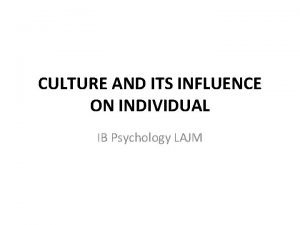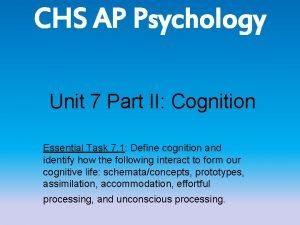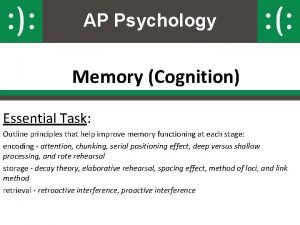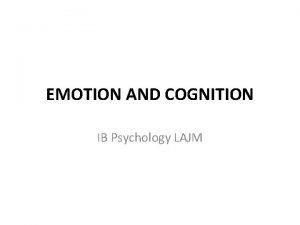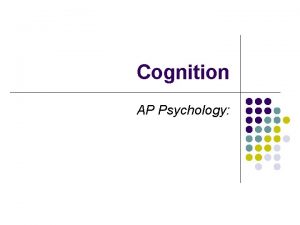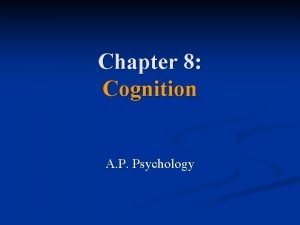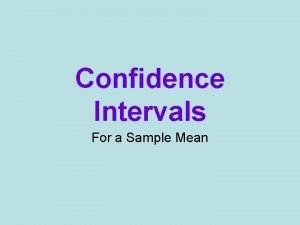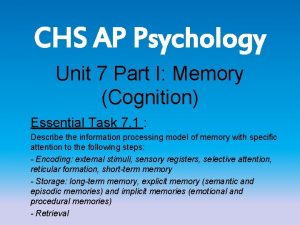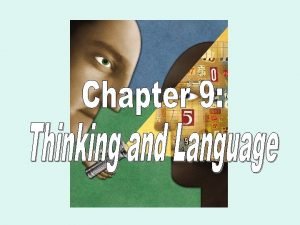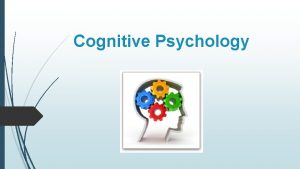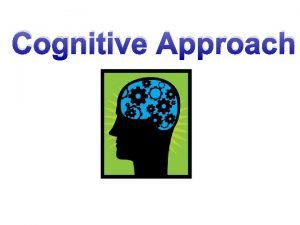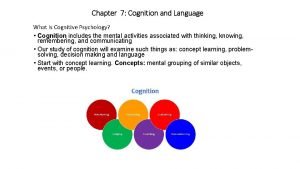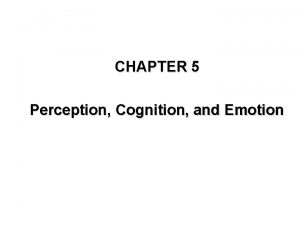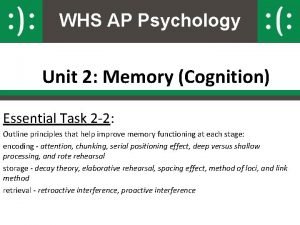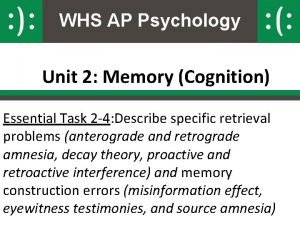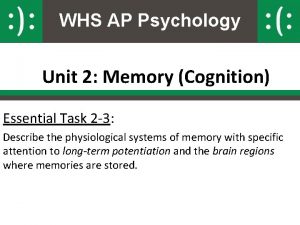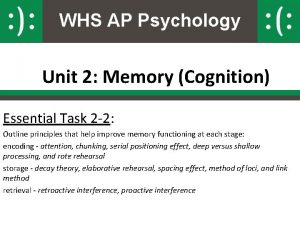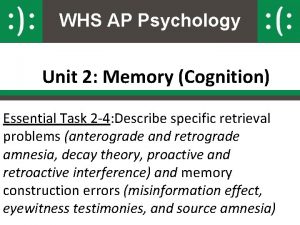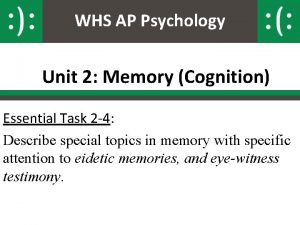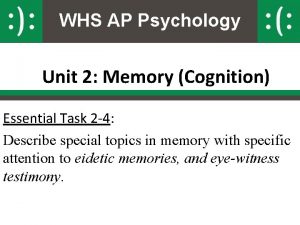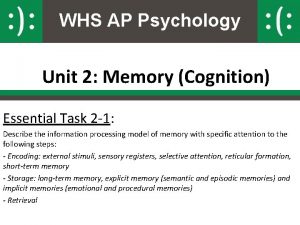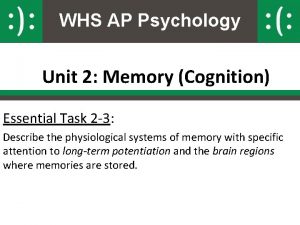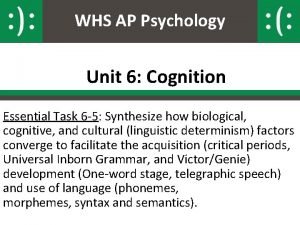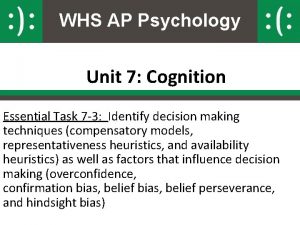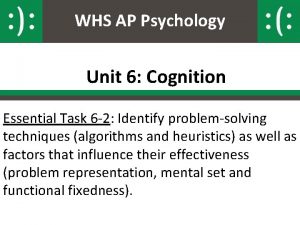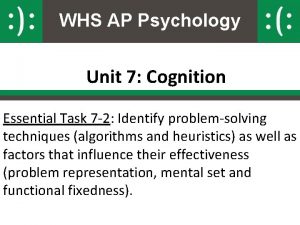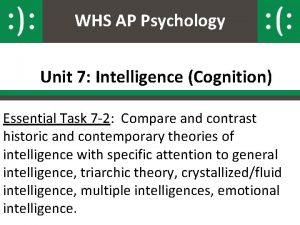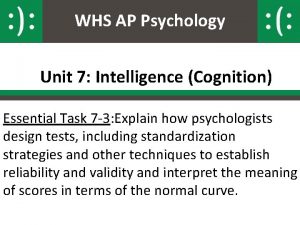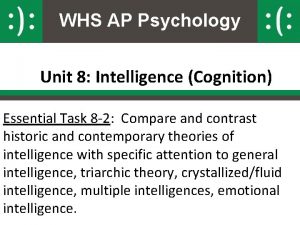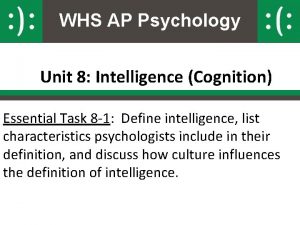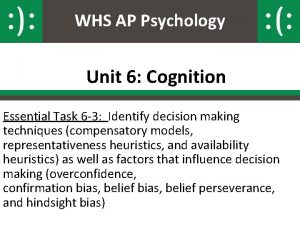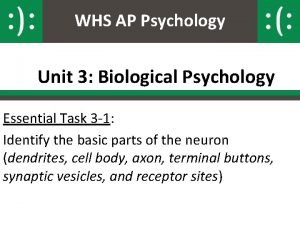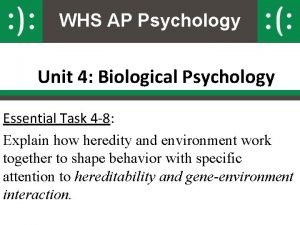WHS AP Psychology Unit 2 Memory Cognition Essential


































- Slides: 34

WHS AP Psychology Unit 2: Memory (Cognition) Essential Task 2 -1: Describe the information processing model of memory with specific attention to the following steps: - Encoding: external stimuli, sensory registers, selective attention, reticular formation, short-term memory - Storage: long-term memory, explicit memory (semantic and episodic memories) and implicit memories (emotional and procedural memories) - Retrieval

Information Processing Model 1. Encoding gone Long Term Memory 2. Storage 3. Retrieval External Stimuli All the rest Retrieval Sensory Registers We are here At ten tio n Short Term Memory

Essential Task 2 -1: Outline • Define memory • Describe the Information Processing Model or IPM for short – Encoding: • • • external stimuli sensory registers selective attention reticular formation short-term memory – Storage: • long-term memory, – explicit memory (semantic and episodic memories) – implicit memories (emotional and procedural memories) – Retrieval

Memory • The ability to remember things we have experienced, imagined, or learned • Memory is often seen as steps in an information-processing model Outline – Encoding – (The process of putting information into digital format. ) – Storage – Hard Drive – Retrieval – Accessing the Hard Drive

Information Processing Model Step 1: Encoding (Blue) Step 2: Storage (Green) Step 3: Retrieval (Red) Atkinson and Shiffren’s Model Outline

Information Processing Model 1. Encoding gone Long Term Memory 2. Storage 3. Retrieval External Stimuli All the rest Retrieval Sensory Registers At ten tio n Short Term Memory

Write down the names of the seven dwarves. Write down everything that comes to you mind, even if you don’t think it is correct. Outline

Recognition is easier than recall • Grouchy, Gabby, Fearful, Sleepy, Smiley, Jumpy, Hopeful, Horney, Shy, Droopy, Dopey, Sniffy, Wishful, Puffy, Dumpy, Sneezy, Lazy, Pop, Grumpy, Bashful, Cheerful, Teach, Shorty, Nifty, Happy, Doc, Wheezy, and Stubby. Outline

Information Processing Model 1. Encoding gone Long Term Memory 2. Storage 3. Retrieval External Stimuli All the rest Retrieval Sensory Registers At ten tio n Short Term Memory Outline

IPM • The IPM works really well to describe effortful processing. • It falls apart a bit with things we automatically process. – Automatic skills (riding a bike) – Conditioned associations (bell to get you to go to your next class). – Time, space, and frequency. • Parallel Processing – brain can work on both at the same time.

Sensory registers/Sensory memory • Sensory registers are the first stop for all sensory information • The sensory registers are very large, but information stays for only a very short time Outline

Visual and Auditory Registers • Visual register holds images, or icons, that represent all aspects of a visual image – Icons normally last about ¼ second in the visual register – Iconic Memory • Auditory register holds echoes of sound – Echoes can last up to several seconds in the auditory register – Echoic Memory Outline • Why do the auditory registers last longer?

Now let us test your visual registers • I will flash the next picture for just ¼ of a second. • DON’T BLINK • After the image flashes we’ll return to a white screen and you can tell me everything you saw. Outline

Outline

Did you pay attention to everything? Outline

Here is another image • DON’T BLINK Outline

Outline

Selective Attention • You select only certain bits of information for further processing from your sensory registers. • We normally pay attention to only a SMALL Outline (PLEASE ENJOY THE IRONIC FONT SELECTION) of incoming information portion

Encoding Outline • Definition – bringing sensory information form the outside world into your memory system. • Some information is stored visually • Research has shown that memory for visually encoded information is better than phonologically encoded information

Reticular Formation Outline


Short-term Memory Outline • Short-term memory holds information we are aware of or thinking about at any given moment • BUT it is much more. It is also working memory! • It’s an active desktop where your brain processes info, makes sense of new inputs, and links it to LTM.

Capacity of Short-Term Memory • Research indicates that STM can hold 7+/- 2 bits of information • Current research has demonstrated that STM can hold whatever is rehearsed in 1. 5 to 2 seconds • Larger amounts of information can be held by using the process of chunking Outline

Let’s see how good your STM is! Outline

Short Term Memory Outline • • 9754 68259 913825 5963827 86951372 719384273 9152438162 15284673189

Chunking Helps • • • Outline 423 -19 267 -198 390 -675 -2 573 -291 -43 721 -354 -456 245 -619 -832 -2 141 -384 -515 -89 201 -315 -426 -762 This is why I assign the concept maps – creates chunks

Encoding in Short-Term Memory Outline • Much information is stored in STM phonologically (according to how it sounds) • Some information is stored visually • Research has shown that memory for visually encoded information is better than phonologically encoded information

Maintaining STM • Information can be held in STM by using rote rehearsal, also called maintenance rehearsal • Rote rehearsal involves repeating information over and over • This technique is not very effective in creating long term memories Outline

Long-term Memory • Everything that is learned is stored in long-term memory • Capacity of long-term memory – Vast amounts of information may be stored for many years – No known limits to capacity Outline

Encoding in Long-term Memory • Most information is encoded in terms of meaning • Some information is stored verbatim • Some information is coded in terms of nonverbal images Outline – Research has shown that memory for visually encoded information is better than phonologically encoded information CONCEPT MAPS CREATE A VISUAL!!!!

Types of Long Term Memory • Explicit memory – Episodic Memory – Semantic Memory • Implicit memory – Procedural Memory @#$!& Outline – Emotional Memory

Types of Long Term Memory • Explicit memory – Memory for information we can readily express and are aware of having – This information can be intentionally recalled – Episodic Memories - Memories for personal events in a specific time and place – Semantic Memories - Memory for general facts and concepts not linked to a specific time • Implicit memory Outline – Memory for information that we cannot readily express and may not be aware of having

Types of Long Term Memory • Implicit memory – Memory for information that we cannot readily express and may not be aware of having – Cannot be intentionally retrieved – Procedural memories: Motor skills and habits – Emotional memories: Learned emotional responses to various stimuli Outline

Retrieval – Bringing information from LTM back to STM Outline
 Psychology unit 7
Psychology unit 7 Acculturation ib psychology
Acculturation ib psychology Cognition definition ap psychology
Cognition definition ap psychology Priming psychology example
Priming psychology example Teacup ib psychology
Teacup ib psychology Embodied cognition ap psychology definition
Embodied cognition ap psychology definition Representative heuristic
Representative heuristic Embodied cognition ap psychology
Embodied cognition ap psychology Wwusd
Wwusd A random sample of 100 whs students
A random sample of 100 whs students Model whs act
Model whs act The elements of a swms (safe work method statement)
The elements of a swms (safe work method statement) Study whs
Study whs Psych unit 7
Psych unit 7 Plamatic acid
Plamatic acid Semantic memory example
Semantic memory example Explicit and implicit memory
Explicit and implicit memory Long term memory vs short term memory
Long term memory vs short term memory Internal memory and external memory
Internal memory and external memory Primary memory and secondary memory
Primary memory and secondary memory Physical address vs logical address
Physical address vs logical address Which memory is the actual working memory?
Which memory is the actual working memory? Virtual memory and cache memory
Virtual memory and cache memory Virtual memory in memory hierarchy consists of
Virtual memory in memory hierarchy consists of Eidetic memory vs iconic memory
Eidetic memory vs iconic memory Shared vs distributed memory
Shared vs distributed memory Belief perseverance
Belief perseverance Mental status speech descriptors
Mental status speech descriptors Sensorium in mse
Sensorium in mse What is cognition
What is cognition Cognition definition
Cognition definition Chapter 7 cognition thinking intelligence and language
Chapter 7 cognition thinking intelligence and language Means end analysis psychology example
Means end analysis psychology example Types perception
Types perception Altered cognition in older adults is commonly attributed to
Altered cognition in older adults is commonly attributed to

